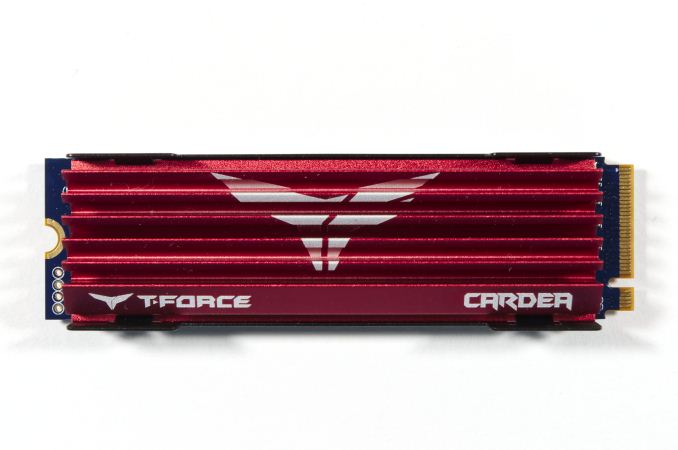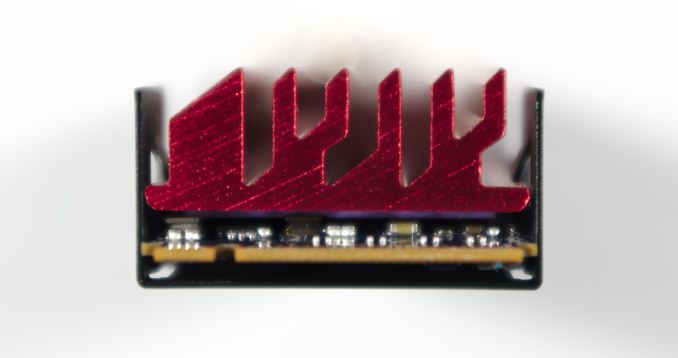The Team Group T-Force Cardea (240GB) SSD Review: Grace Under Write Pressure
by Billy Tallis on September 28, 2017 8:00 AM EST
Team Group is a major vendor of DRAM modules, and they also have a variety of SSDs. They are one of the few SSD vendors that uses Phison turnkey solutions for some of their SSDs but still also designs their own drives using controllers from other vendors like Marvell. Most brands that use Phison have abandoned in-house drive or firmware development.
The Team T-Force Cardea is an enthusiast-oriented M.2 PCIe SSD carrying a large heatsink that makes it more or less a desktop-only SSD. The heatsink is not so tall that it will interfere with graphics cards when installed in a nearby slot, but this heatsink is far more substantial than the low-profile heatspreaders we've seen on other M.2 PCIe SSDs. Underneath the heatsink, the T-Force Cardea is a reference design Phison E7 NVMe SSD with 15nm MLC NAND.
The 240GB Team T-Force Cardea is the lowest capacity SSD we've tested that uses the Phison E7 controller. This gives us the chance to see how well the performance holds up with less spare area on the drive and fewer NAND dies to use in parallel. The 240GB T-Force Cardea is still large enough to fully populate the NAND channels on the E7 controller, so it isn't in an awkward position like the Intel SSD 600p.
SSDs using the Phison E7 controller have all used Toshiba 15nm planar MLC NAND; the controller doesn't support LDPC error correction or anything similar, so it is generally not regarded as a good match for TLC NAND. Despite using MLC, Phison E7 drives have often been some of the most affordable consumer NVMe SSDs, even when compared against drives using planar or 3D TLC NAND. We tend to regard Phison E7 SSDs as entry-level NVMe products, but a desktop-only drive with a heatsink clearly aspires to be more than that.
| Team T-Force Cardea Specifications | |||
| Capacity | 240GB | 480GB | |
| Form Factors | M.2 2280 PCIe x4 with heatsink | ||
| Controller | Phison E7 | ||
| NAND | Toshiba 15nm MLC | ||
| Sequential Read | 2600 MB/s | 2650 MB/s | |
| Sequential Write | 1400 MB/s | 1450 MB/s | |
| 4KB Random Read | 180k IOPS | 180k IOPS | |
| 4KB Random Write | 140k IOPS | 150k IOPS | |
| Encryption | No | ||
| Write Endurance | 335 TB | 670 TB | |
| Warranty | Three years | ||
| Price | $129.99 | $219.99 | |
The performance specifications for the two capacities of the T-Force Cardea are very similar, suggesting that the larger model won't feel any faster. The warranty period of three years is typical for this market segment, and the write endurance ratings are equivalent to about 1.2 drive writes per day over that period, which is very good for a consumer drive.
Each Phison E7 drive we've tested has used a different firmware revision that makes different performance tradeoffs. Our most recently reviewed Phison E7 SSD was the Corsair Neutron NX500 with firmware version 4.5, which seemed to prioritize peak benchmark performance over low queue depth real-world performance. The Patriot Hellfire's version 2.1 firmware seemed to be pretty well-rounded with reasonable priorities. The Team T-Force Cardea uses Phison's version 3.6 firmware. We also have results for the Zotac SONIX with 1.0 firmware.
Aside from comparing against other Phison E7 SSDs, the most relevant competitor to the 240GB Team T-Force Cardea is the 250GB Samsung 960 EVO. The 960 EVO uses the most advanced NVMe SSD controller currently available, but is held back somewhat by using 3D TLC instead of the 3D MLC of the 960 PRO, and the 250GB capacity often suffers from the small size of its SLC cache and spare area. At the moment, the 960 EVO is a bit cheaper than the T-Force Cardea.
| AnandTech 2017 SSD Testbed | |
| CPU | Intel Xeon E3 1240 v5 |
| Motherboard | ASRock Fatal1ty E3V5 Performance Gaming/OC |
| Chipset | Intel C232 |
| Memory | 4x 8GB G.SKILL Ripjaws DDR4-2400 CL15 |
| Graphics | AMD Radeon HD 5450, 1920x1200@60Hz |
| Software | Windows 10 x64, version 1703 |
| Linux kernel version 4.12, fio version 2.21 | |
- Thanks to Intel for the Xeon E3 1240 v5 CPU
- Thanks to ASRock for the E3V5 Performance Gaming/OC
- Thanks to G.SKILL for the Ripjaws DDR4-2400 RAM
- Thanks to Corsair for the RM750 power supply, Carbide 200R case, and Hydro H60 CPU cooler

















22 Comments
View All Comments
MajGenRelativity - Thursday, September 28, 2017 - link
While this drive doesn't seem too interesting, I'm very interested in your upcoming review on M.2 Thermal Throttling!Pinn - Thursday, September 28, 2017 - link
You should see it by using ~10G files and a ram drive. The Intel card SSD is much more consistent than the M.2 sticks I've tried.Dr. Swag - Thursday, September 28, 2017 - link
Did you guys change some things? Because it feels like some of the results are different, as I remember the 960 evo doing a lot better before...evilspoons - Thursday, September 28, 2017 - link
These results only include the 250 GB 960 Evo, which is the bottom of the line for the 960 series. IIRC the controller is kneecapped due to having a minimum number of NAND chips available and has no parallel processing ability... hence why reviews like this are interesting!Billy Tallis - Thursday, September 28, 2017 - link
Yep. Our initial review of the 960 EVO only included results from the 1TB model, because our first 250GB sample died during testing. The replacement has been working fine, but its performance profile is very different from the 1TB.The relationship between performance and capacity was the biggest reason I wanted to review this drive; it was the first 240GB Phison E7 sample offered to us.
mapesdhs - Thursday, September 28, 2017 - link
It's shocking how much better than 950 Pro is over the 960 EVO a lot of the time. Other reviews show the EVO has issues with steady state performance even at higher capacities. It's why I bagged a lightly used 950 Pro 512GB recently; noticed someone else no doubt delighted at getting another for 130 UKP BIN. :D And of course, the 950 Pro has its own boot ROM (why the heck did Samsung ditch that? Such a useful feature for older chipsets).CheapSushi - Sunday, October 1, 2017 - link
There's an inherent performance and latency difference between MLC (Pro) and TLC (EVO) NAND. Even with updates, better controllers, etc, it is always there (2 bits per cell vs 3 bits per cell).Dr. Swag - Thursday, September 28, 2017 - link
Ah I see. Interesting to see such a large performance gap, though I guess it makes sense.Gasaraki88 - Thursday, September 28, 2017 - link
I wonder why you guys never reviewed the MyDigitalSSD BPX. It's one of the fastest Phison E7 controller SSDs and the cheapest.DanNeely - Thursday, September 28, 2017 - link
MyDigitalSSD would have to send one in for review...